I’m not sure what the story is behind the paint selection on this rare 1954 Kaiser Darrin (you’re looking at #88 of only 435 ever produced), but it looks gorgeous. Although Darrins weren’t offered in this particular shade of green (they only came in four colors: a light green called Pine Tint, Red Sail, Yellow Satin, and an off-white called Champagne), this color gives the roadster an elegant look that also accentuates it’s unique, sweeping body lines. This restored Darrin is Lot# 684 and is being offered at No Reserve at the October 20-22 Barrett-Jackson Collector Car Auction in Houston, Texas. A big thanks to our Barn Finds buddy, Larry D., for spotting this rare one and sending it our way.
When introduced in 1954, the Darrin’s advertising had a glamorous and tasteful look to it and proclaimed Kaiser’s new roadster as “The new name in sports cars, the last word in elegance.” and “A new criterion of motoring performance, a new standard of luxury.” And those in charge at Kaiser definitely wanted to position the Darrin as having European styling claiming that it was “styled by Darrin of Paris” and that “it employs a minimum of chrome to achieve the classic elegance which is the mark of a truly distinctive sports car.” As you can see, even 68 years later, it’s still a sleek and stylish fiberglass-bodied roadster (only 36 inches high from road to cowl and only 50″ high with the top up).
Continuing with Darrin’s advertising lingo, they referred to its low and sleek Fiberglass body as “armor-clad,” and it’s revolutionary sliding doors (that slid into the front fender) as both providing additional safety and convenience. Kaiser also bragged about the Darrin’s unique “Deauville-style” convertible top that could be set in three positions, and its unique rear deck that easily stored the convertible top when not in use. Unfortunately there are no photos of the convertible top. I’m curious what color fabric was chosen to compliment the nice green paint job.
The Darrin had one of the most luxurious cockpits offered in 1954, and this one is tastefully appointed in two-tone green and looks perfect. Advertising promised bucket seats nearly 24 inches wide and upholstered in the finest top-grain leather and also touted the Darrin’s “rakishly slanted one-piece windshield that provides maximum visibility in all directions.”
This groundbreaking roadster was name after its designer, Howard “Dutch” Darrin. Upfront you’ll find a powertrain that Dutch hadn’t envisioned, but the brass at the fledgling Kaiser-Willys Company decided on: a 161-cubic inch Willy’s F-head inline-six that generated 90 horsepower. It’s mated with a three-speed manual overdrive transmission. At 2,176 pounds, you could do 0-60 in :15, which was average performance for the day, but again, Darrin was hoping for better performance.
With only 435 produced and an estimated 200-300 survivors, Darrins in this kind of showroom-new restored condition generally fetch triple figures. Hagerty’s estimates the value of a Darrin in #1 condition at $174,000 and one in #2 condition at $117,000. I’ll be curious to see how much green this green dream machine fetches.
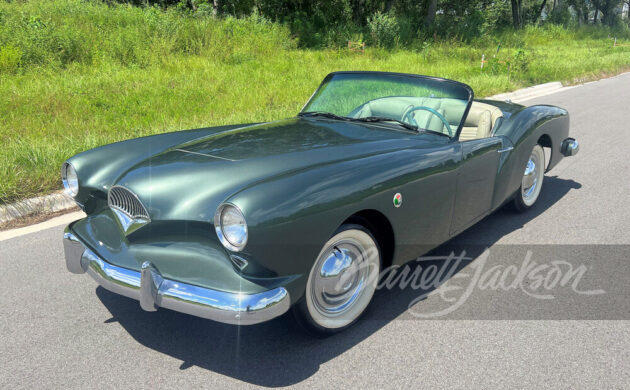
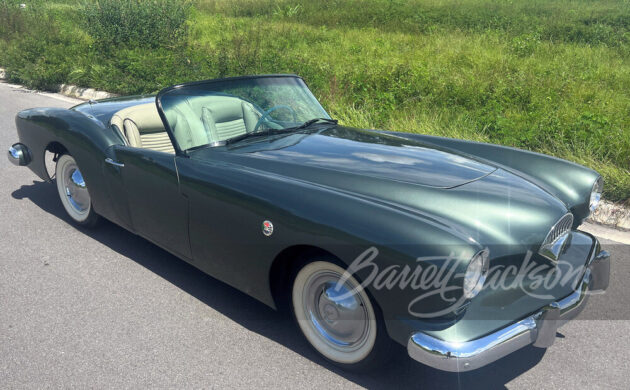
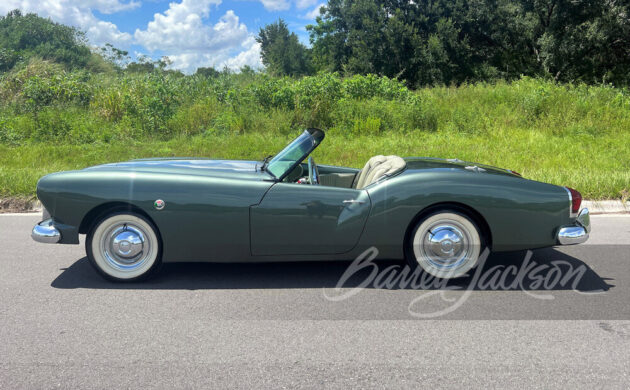
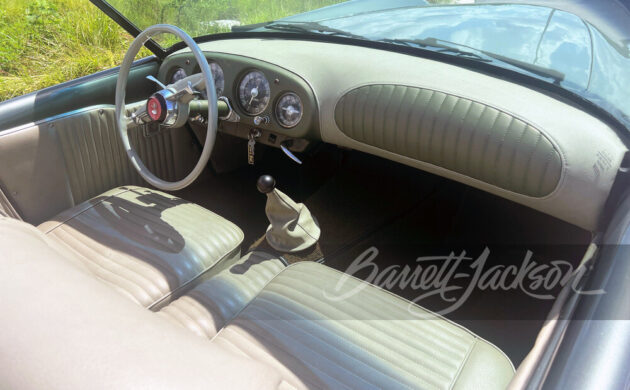

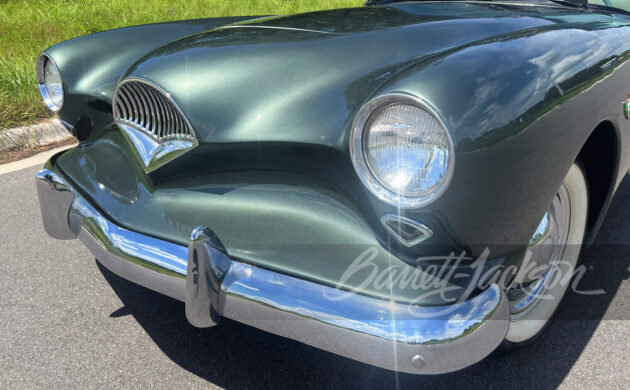


I believe the shade of green the K-D came in was “Pine Top.” It was a very soft green, much lighter than this. This looks okay, but I prefer original….
Oh, and “Dutch” Darrin got the “better performance” he wanted after the Kaisers bowed out of the project. He acquired 50 of the unsold leftover K-Ds and installed Cadillac V8s in them.
Wow, I bet these things would’ve been pretty zippy with the Caddie V8!
Oooops! That should have been “Pine Tint.”
Don’t remember things as well as I used to….
Ray have you ever seen any of the v8 cars people talk about. I have beenooking for years and have not found one.
Wow what a slug of a motor! It looks like it’s doing 100mi/hr sitting, but oh my…
I like the green but cannot stand the tinted and shaded windshield! Especially the shading at top. Doesn’t look period at all.
So I did a little internet searching and, recognizing that no one on the internet ever cites sources, the consensus is that window tinting was first offered in the late 50’s and really only from the manufacturers (1958 Chevrolets are cited, but these sites all just quote each other). So, you may be right: a 1954 Darrin may not have had factory tinted windshield. Having been born in 1961, I don’t really care.
I’m pretty sure that you could get factory tinted glass (Solex) on Studebakers as early as ’53, but I don’t think it included the sun band at the top of the windshield.
I was born in 1961 , and I agree with Pwog – it doesn’t look right on a car of this period – Kind of like putting fender skirts on a 67 Camaro
I was born long before 1961 and my dad’s brand new 1952 Chrysler Saratoga (V-8) had tinted glass. It was an option that was ordered on the car.
I like it, look like the color choices of paint and interior give it a newer look as well as the tinted glass. These were good looking cars just possibly a little ahead of their time in design.
Those do not look like the stock sliding doors. Were they changed to conventional doors at some point?
Agreed. Those doors look like they protrude into the rear fender. Original car did not – the doors slid into the front fender to open. For those not familiar, see here https://en.wikipedia.org/wiki/Kaiser_Darrin#/media/File:1954_Kaiser_Darrin_dash.jpg
“a 161-cubic inch Willy’s L-head inline-six” Stand back, don’t let it get away from you!
Engine isn’t an “L-Head six”. It’s a F Head, intake valves in the head, exhaust in the block. Provides much better breathing, more efficient design. At 90 HP for only 161 Cubes, compare with the Chevy 216 with 90 HP. The independents had to compete with more inovative designs.
You are correct, sir, and it has been corrected to an “F”. Thank you!
They’re even more impressive in person as they are in photos.
A few slipped through with the blower as used on the sedans as an option.
Okay let me stir up something. An “F” head engine has intake and exhaust valves in the block. I do not know of any engines that had the above described engine except one. Around 1917- 1918 Fiat or Peugeot had this the valve configuration which I could not believe my eyes when I saw it in a big touring car. I saw this car in 1966 in Memphis at an old farm . There was a number of parts for different antique cars just laying around including engines, and I do remember an old White engine. Please correct me if you can find anything different in your research, I would love to know.
The F head does have an exhaust valve in the block (L head style) and an intake valve in the head. Longest production engine in history (4 cylinder version). Now before you small block Chevy guys jump down my throat, consider that from 1948 to 1972 the Willy’s F Head was built by three different auto companies and it had zero changes. Every bolt interchanges from the first to the last. The one change that did come in the 60s was a remote spin-on oil filter that screwed into the stock filter canister port as a bolt on addition. The engine remained unchanged.
Who needs an Italian coachbuilder, when you have Darrin? This car is breathtakingly beautiful by any standard.
With or w/o the Caddie 8 cylinder, it looks like there could be room in the engine bay for bolt-ons like air conditioning, cruise control, etc. I wonder if the corvette guys were peeking in their studio – or vice-versa – both vehicles being fiberglass roadsters – this one looks longer and wider, but if your parked them side by side, they might look like family – probably a book about it somewhere.
That 36-inch measurement to the top of the cowl must have been a thing back then. I owned a 1955 Corvette years ago. I bought period advertising for that car and Chevrolet bragged that the Corvette was only 33 inches high!! Say what?? I also had a 1969 Corvette at the same time and I knew its owner’s manual said it was 47 inches tall.
So I had no idea how the ’55 could be 14 inches shorter than the ’69. And finally, I was talking to Noland Adams one evening (google his name if you don’t know who he is) and I told him the ’55 Corvette brochure said it was only 33 inches tall. I asked how that was possible. And he informed me that measurement was at the cowl. Oh!!!!! So now I understood what it was but my next question to Noland was WHY they did that. And he said he knew everything about Corvettes but he didn’t know that. LOL
And by the way, if you love Corvettes, you SHOULD know who Noland Adams is!
just stopped by 2C what these glass rigs fetched fora price these daze. Hummm… climbing (like everything else, eh). Should B surprised, but no. Must B gettin used to it~
0 rear wheel well liners. this thing was built light!
As a Kaiser Darrin owner I will say the owner personalized this car to their own taste. The doors are heavily modified both in shape and operation. The windshield frame should be chrome. Tinted windshield and white wall tires were standard on all Darrins. Under the hood wiring, hoses and fuel lines are also not as original. Interesting that in the RM write-up they make no mention concerning the modifications.
I should have said Barrett Jackson Auction
Sold at Barrett Jackson Auction 10/22/22 for $75,000 plus Buyer fees